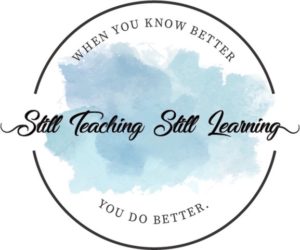
We are about six weeks into the school year – just about the time I am re-evaluating what is working for my class and what is not working.
Even though I keep focusing on what is frustrating me or “not working,” I forced myself to make a list of everything that IS going well.
Here are the good things:
*most students log in to Google Meet on time
*most students immediately mute their microphones when they log in!
*most students report positive feelings about school and their emotional well-being during SEL check-ins
*most students are completing work on time
*most students are doing quality work
*most students are using opportunities to ask questions about assignments or get extra help
*parent feedback is positive overall
*our schedule allows for a good mix of on-screen and off-screen time

So what do I have to complain about, right?!
Here’s the thing: until ALL of my students are doing the above, I am going to continue to feel some frustration and some sense of “I need to fix this.”
Here is a list of some of my current frustrations:
*a few students are not completing work (or not completing it on time)
*a few students think they are “done” when they are not in a live session with a teacher
*a few students don’t show up for small groups on time (or don’t show up at all)
*a few students leave the Zoom call or Google Meet before I am finished with directions
*a few students feel disconnected from the class
*a few students always keep their cameras off (which is an option in my class, but I want to be sure they’re okay and I can’t really tell)
*a few students think they don’t need any help, but clearly they do
*students get overwhelmed by email notifications from Google Classroom and are unsure about how to find missing assignments
*how to get more engagement during Google Meet lessons when we can’t use familiar strategies like turn & talk
*there is never enough time for all the reading groups, writing conferences, and small group instruction that I know my students need.

After making this list of what is irritating me or causing me stress, I started thinking about what I can do to fix the frustrations.
The first thing I did, which I highly recommend, was email and text different teachers I respect. The funny thing is: they shared the same frustrations, plus a few of their own! However, they also offered a few suggestions that are working for them and I was able to share a few of mine. Between us, we came up with some good ideas that are worth trying.
The next thing I did was start making lists of what I need to do and who needs specific strategies.

Here is my list of what I am going to try for the next few weeks:
1 – Start by actually asking my students what they need. How many times do we just jump in with all of our new strategies when those strategies may not be what our students really need? Or is that just me?!
I have a list of who I need to meet with this week, and that will be my first question: “How’s it going?”I may need to go on to explain what I am seeing (or not seeing) and then ask them what they need from me in order to be more successful.
With these meetings, I am asking one student at a time to just remain on the Meet right after we finish math or science or reading. After everyone else leaves, then we will have our private conversation. That way, I don’t have to worry about them not showing up for a different meeting time.
2 – Today I met with two students who are not completing work or not doing it in a timely way. What I realized is that these students are not defiantly refusing to complete assignments. They expressed that they just get overwhelmed and aren’t sure what to do first. Finding out what their particular “pain point” is will help me to better help them. I will continue these meetings with other students this week.
One of the good things to come from all of this remote teaching and learning is the sharing of tips and videos from teachers all over the world. I found this video that explains to kids how to turn off email notifications of assignments, but keep the feedback emails. Just what I needed! Thanks, Sarah Rines & Marisa Thompson!

3 – One student who has not been completing work in a timely way also has the idea that he is “done” when he is not in a live Meet. While it might seem obvious to us that students should use asynchronous time for completing assignments, they don’t always make that connection. With this student, I made a simple checklist with the times for our live Meets, then a specific task to complete at specific times of the day. We’ll see how it goes. He seemed relieved to see everything broken down into “do-able” pieces, so I hope it helps!
4 – Another student keeps forgetting to show up for small group times with me and with other teachers. I used the same checklist template and made a list for her with the various times and Meet codes. I found that part of her problem is just losing track of time and not realizing it’s time to go to P. E., for instance. I showed her how to set an online alarm. Here is the one we used. Hopefully, this will help!

5 – I heard a great suggestion from another teacher about how to signal kids that we are “done” with the live Meet and they can disconnect: she waves goodbye to them! She has taught her students that until she says goodbye and waves to them, they should stay connected because she is still giving directions or reminders. So simple, but it worked for us today!
6 – It’s tough when students feel disconnected. I know that they all miss the social aspects of school, even the most introverted of students. I am trying to provide more opportunities for students to chat in small groups, even when we are meeting for an academic purpose. I am also deliberately scheduling social Meets for small groups of students so everyone can have a chance to chat. I am making the social Meets optional, but I have found that all of my students tend to show up.

Some ideas I have seen for helping keep students connected:
This article from Edutopia – “Nurturing a Classroom Community During Distance Learning” has some great ideas for “shrinking the class.”
Some of the strategies I am going to try include:
~one-to-one conferences with students
~small group social meetings
~creating study groups. She calls them “home teams, intentional groups, and intelligent pairings.” I am going to start with (somewhat) random groups of six that will meet together at an assigned time during our asynchronous learning block. This week I will have them do some review of our weather unit concepts.
I am still modifying how to do this, but here is my current idea: I will choose a “leader” to start the group discussion. I will email the leader with suggested prompts and things to say get the review started and to include everyone in the conversation. I’ll let you know how it goes!
Since we use Google Meet and do not yet have the breakout room function, it takes a few more steps to create smaller group Meets that I can monitor. Let me know if you want to know the steps I use for this.
~another idea I’ve had that works well is to assign every student a “buddy” that they greet personally at the beginning of our morning meeting. We don’t do this every day, but we do it frequently (maybe two or three times a week). The way it works is that I greet a student: “Good morning, Claire.” Claire replies to my greeting and then greets her buddy: “Good morning, Mrs. Smith. Hi, John.” Then John replies to Claire’s greeting and greets his buddy: “Hello, Claire. Good morning, Elliott.” And so it goes.
It might sound silly but it helps everyone know and use everyone’s names and it helps all students to feel “seen,” not just by me but by their classmates as well.

7 – issues with keeping cameras off – this is a tough one. I don’t want to make cameras being on a mandatory thing in my classroom, since there are so many different and valid reasons why students may prefer to keep their cameras off. I am discussing it with them when we have individual conferences and asking them about their reasons. I would not have done this during the first week of school when they didn’t know me yet.
Here’s my “script” for having the conversation:
“I’ve noticed that you always/almost always keep your camera off during our Meet times. Can you tell me why you prefer that?” (If they are reluctant to discuss, I reassure them that it’s fine to keep the camera off but that I like to see their face and I know their classmates would like that as well.)
If they say something like, “I don’t know. I just like it better,” I say the same thing — that we all would prefer to see their face instead of an icon so I would like for them to try it for one lesson.
If they give me a reason that concerns their background, family members being nearby, whatever their concern might be, I thank them for telling me and reassure them that it is fine for them to keep the camera off.
In some cases (when I know there is no home/family/privacy reason for the camera being off), I am mentioning it to parents in a check-in email.
Here’s what I’m saying:
“I wanted to check in with you about how _____ is doing with online learning. I’ve noticed that _____ usually keeps their camera turned off during lessons. That is fine with me if it’s okay with you. Is there anything I can do to help or support?”
I have found that most parents want their children to keep their camera turned on since it helps their child to be more engaged in the lesson. Then I can also mention that to the student when we meet together.

8 – Students who think they don’t need help, but clearly they do. If we were in the classroom, I could have students join me for a small group to work on whatever they need to review, but that is much more difficult to do with distance learning.
One thing I have been doing with some success is telling certain students that they need to stay with me at the end of a whole class Meet. Then we review the lesson, I get them started on the independent work, and let them go. (But I can’t do that while I am doing the quick 1:1 check-ins with students – sigh. There are always trade-offs.)
I am thinking about doing some math review or science review with the “study groups” (mentioned above).
I’ll keep working on it, but I hope you will share your tips with me!

9 – Students being overwhelmed by email. I do love Google Classroom, but hate getting notified about every single little thing. Students feel the same way. They are missing important emails because they are getting “lost” amongst all the emails in their inbox. As mentioned above, I found this video to show my fifth graders how to turn off the notifications of assignments, but keep the emails about feedback and graded assignments.
Another thing I have been doing is offering to have one-on-one “clean out your email” sessions. During these sessions, I have the student share their screen, open their inbox, and then we go through it with me telling them what they can delete. We all feel much better when our “space” is decluttered!
10 – Engagement strategies for Google Meet (or Zoom:)
~One of the simplest ways to ensure more engagement is to start with a social-emotional learning check-in. (Some people call these icebreakers or warmup questions.)
Somehow starting off with something that does not require academic thought helps students connect with me and with each other and it gets them started thinking about their opinions in a low-stress way. Something as simple as “on a scale of 1-5, tell me how you’re feeling right now.”
I like using “would you rather” questions but I am also keeping a running list of questions to ask so I don’t end up using the same ones over and over. Let me know if you would like to see my list and I will clean it up and post it!

~Find checkpoints where you can ask students to respond or engage. I try to do this every 3-5 minutes. During math, you might have them hold up their whiteboard or paper to show their work on a problem. You could have them answer a question in the chat. You could have everyone unmute their microphone and respond to a question. Anything that keeps them thinking and responding is a good thing!
~Use wait time. Tried and true because it gives everyone a chance to think before you choose someone to respond. This helps cut down on the blurts and it shows students that you care more about a thoughtful answer than about a quick answer.
~Use some kind of system where you randomly draw student names and ask them to respond. This is not intended as a “gotcha,” but as a way to be sure you equitably call on everyone and give them a chance to respond. You could use popsicle sticks with student names on them, names on paper that you draw from a cup or bowl, or use an app like Popsicle Sticks.

~Use the “whip-around” strategy. This is when you ask a question and then “whip around” the circle or classroom and every student responds. Even if they say the same thing over and over, it gives everyone a voice.
~Have students add a response to a Padlet wall.
~Using American sign language. I saw this great article on Edutopia – “How Using a Little Sign Language Can Improve Online Classes.” It teaches some simple signs for “again,” “slow,” “same” (to show agreement), “applause,” and “understand.”
I realize there are probably tons of other signs that would be useful, but I plan to teach one of these every day and ask students to use them and to remind me to use them too!

11 – never enough time for all the meetings and groups that are needed. I have no great solutions for this as it is an ongoing problem, even when teaching in a building.
My best tip is to keep a class chart handy where you note every time you meet with individual students, whether it’s in a small group or in a one-on-one conference. As you plan for groups and conferences for the day (or the week), take note of who you have not “seen” recently and look for where you can plug them into a group or meet with them alone, even for just five minutes.
Watch for an upcoming post where I’ll share some tips for virtual reading conferences and virtual reading groups.
Teaching is always a challenge, regardless of your circumstances. I hope some of these tips give you ideas for overcoming your own frustrations. And I hope you’ll share what’s working for you!
